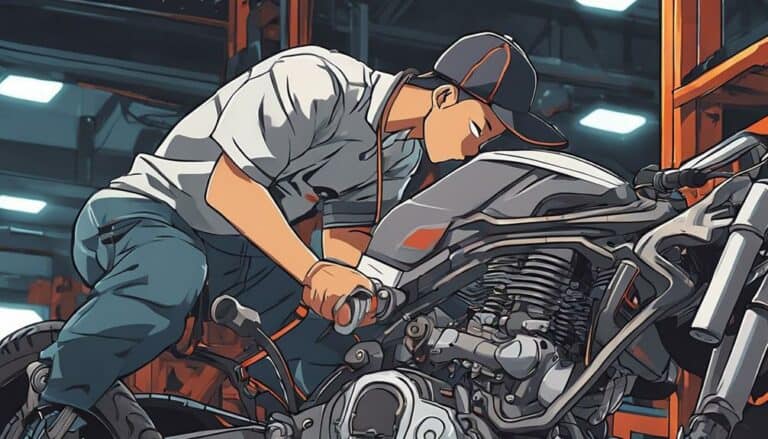When breaking in your 2-stroke dirt bike post-new piston installation, imagine the excitement of unlocking its full potential while ensuring its longevity.
The initial steps are vital, setting the tone for how the engine will perform in the long run. Consider the impact of each heat cycle on your bike's overall health and performance. Understanding this process will not only optimize your engine's capabilities but also safeguard your investment.
Learn how to navigate this critical phase to maximize your dirt bike's potential and reliability.
Key Takeaways
- Initiate break-in with three heat cycles for optimal piston performance.
- Monitor engine for abnormalities post-rebuild to prevent issues.
- Avoid common break-in mistakes to ensure piston longevity.
- Follow proper break-in steps to prolong piston life effectively.
Importance of Proper Break-In Process
Properly executing the break-in process is essential for ensuring the longevity and peak performance of your 2-stroke dirt bike engine after installing a new piston. Failing to adhere to the proper break-in procedures can lead to premature wear of engine components, affecting the overall running of your bike.
During the break-in period, the internal components of the engine are settling into place, and the piston and rings are adjusting to their respective positions. This process is critical as it allows for proper heat distribution and cooling within the engine, preventing overheating and potential damage.
When the break-in process is done correctly, it contributes to a smoother running engine by ensuring that all parts work harmoniously together. This harmonization is important for the engine's health and longevity, as it minimizes the risk of malfunctions and optimizes performance.
Following the manufacturer's recommended break-in procedure is important for guaranteeing that your 2-stroke dirt bike engine operates at its best capacity.
Step-By-Step Break-In Instructions
To initiate the break-in process for your 2-stroke dirt bike after installing a new piston, begin by performing three heat cycles.
The first cycle involves idling the bike for 10 minutes with occasional throttle blips. Next, take the bike for a road ride through the gears at half throttle for the second cycle. Finally, for the third cycle, give the bike a full throttle run.
Remember to warm up the bike properly before engaging in hard runs to prevent cold seizing, especially with new pistons. Allow the bike to cool down completely between each heat cycle to prevent overheating.
Never push the bike hard when it's cold; wait until you can feel the warmth of the radiator indicating the cylinder is adequately warm. Proper lubrication is essential during this phase to avoid engine failure due to seizure or premature ring wear.
Following these steps promotes a proper break-in procedure for your new piston and promotes top-notch engine performance.
Monitoring Engine Performance Post-Rebuild
After completing the break-in process for your 2-stroke dirt bike following a new piston installation, the next step is to monitor the engine's performance post-rebuild by observing for any abnormal noises, vibrations, or changes in exhaust smoke color and consistency.
Be vigilant for any irregularities in throttle response and power delivery, as these can indicate underlying issues. Additionally, keep a close eye out for any signs of oil leaks or coolant loss, as these could point towards problems with the rebuild.
It's important to track changes in the bike's performance or behavior meticulously to detect and address potential issues early on.
By diligently monitoring engine performance and conducting regular checks for abnormal noises, exhaust smoke variations, oil leaks, coolant loss, throttle response, and power delivery, you can guarantee that your 2-stroke dirt bike continues to run smoothly post-rebuild.
Stay proactive and attentive to maintain your bike's best performance and longevity.
Avoiding Common Break-In Mistakes
When breaking in a 2-stroke dirt bike after a new piston installation, it's important to avoid common mistakes that could compromise the engine's performance and longevity. To guarantee a proper break-in process, follow these essential steps:
- Guarantee Proper Warm-Up: Before riding aggressively, let the engine warm up adequately to prevent cold seizing, especially important for forged pistons.
- Implement Heat Cycles: Utilize a three-step heat cycle method – start with 10 minutes of idling with occasional throttle blips, then go for a road ride shifting through gears at half throttle, and finally, a full throttle run.
- Let It Cool Down: Between each heat cycle, allow the bike to cool down entirely. This prevents overheating and potential damage to the engine components.
- Monitor Radiator Heat: Pay attention to the warmth of the radiator as it can indicate when the cylinder is sufficiently warm for a proper break-in process.
Tips for Prolonging Piston Life
Prolonging the life of your piston on a 2-stroke dirt bike requires careful maintenance and adherence to proper operating practices. When breaking in a new dirt bike piston, make sure to follow the three heat cycle method. Avoid running it hard during the break-in period; instead, ride the bike at half throttle to allow the piston rings to properly seat against the cylinder walls.
It's important to make sure the engine is adequately warmed up before pushing it to prevent cold seizing, which can lead to damage requiring engine rebuilding. Always monitor the warmth of the radiator to gauge the cylinder head's temperature accurately. Additionally, allow the bike to cool down completely between each heat cycle to prevent overheating and potential piston damage.
Conclusion
Congratulations, you have successfully broken in your 2-stroke dirt bike after installing a new piston.
Remember, a proper break-in process is essential for best engine performance and longevity.
So, next time you're tempted to rev it up right away, just think about those heat cycles and the care you've taken to make sure your bike's longevity.
Happy riding!

